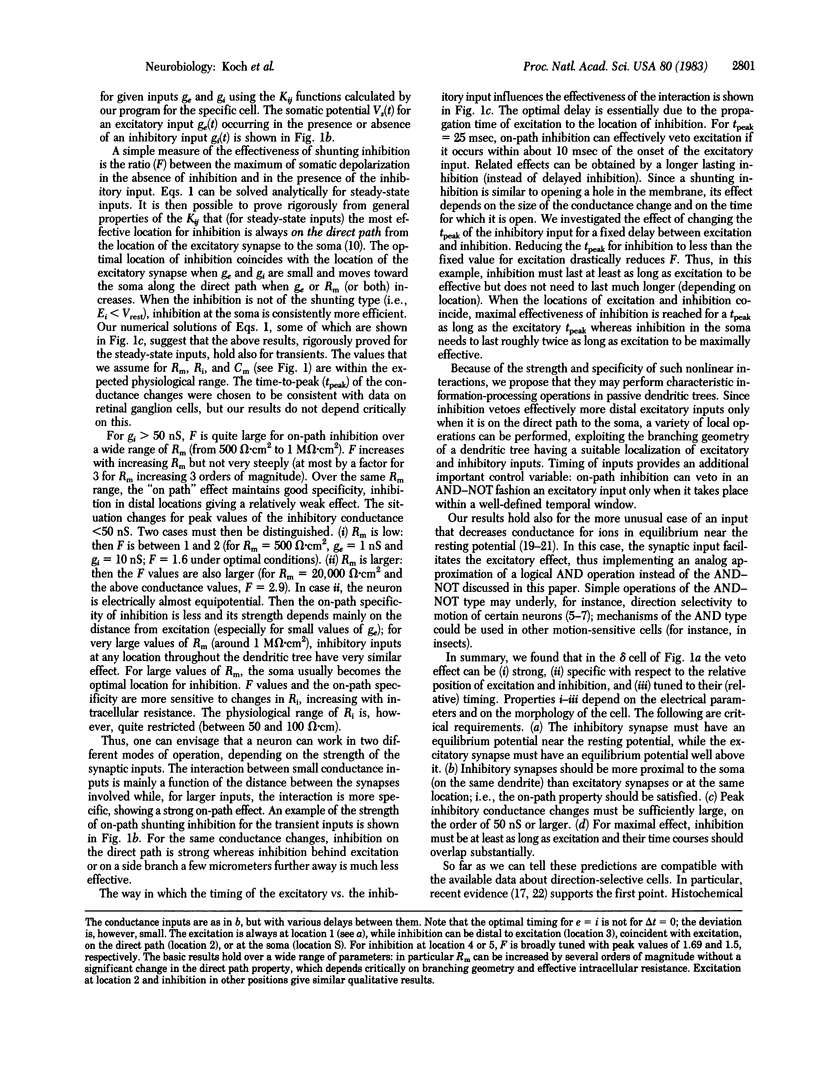Abstract
In a passive dendritic tree, inhibitory synaptic inputs activating ionic conductances with an equilibrium potential near the resting potential can effectively veto excitatory inputs. Analog interactions of this type can be very powerful if the inputs are appropriately timed and occur at certain locations. We examine with computer simulations the precise conditions required for strong and specific interactions in the case of a delta-like ganglion cell of the cat retina. We find some critical conditions to be that (i) the peak inhibitory conductance changes must be sufficiently large (i.e., approximately equal to 50 nS or more), (ii) inhibition must be on the direct path from the location of excitation to the soma, and (iii) the time course of excitation and inhibition must substantially overlap. Analog AND-NOT operations realized by satisfying these conditions may underlie direction selectivity in ganglion cells.
Full text
PDF



Selected References
These references are in PubMed. This may not be the complete list of references from this article.
- Ariel M., Daw N. W. Pharmacological analysis of directionally sensitive rabbit retinal ganglion cells. J Physiol. 1982 Mar;324:161–185. doi: 10.1113/jphysiol.1982.sp014105. [DOI] [PMC free article] [PubMed] [Google Scholar]
- Barlow H. B., Levick W. R. The mechanism of directionally selective units in rabbit's retina. J Physiol. 1965 Jun;178(3):477–504. doi: 10.1113/jphysiol.1965.sp007638. [DOI] [PMC free article] [PubMed] [Google Scholar]
- Barrett J. N., Crill W. E. Influence of dendritic location and membrane properties on the effectiveness of synapses on cat motoneurones. J Physiol. 1974 Jun;239(2):325–345. doi: 10.1113/jphysiol.1974.sp010571. [DOI] [PMC free article] [PubMed] [Google Scholar]
- Barrett J. N. Motoneuron dendrites: role in synaptic integration. Fed Proc. 1975 Apr;34(5):1398–1407. [PubMed] [Google Scholar]
- Baylor D. A., Fettiplace R. Synaptic drive and impulse generation in ganglion cells of turtle retina. J Physiol. 1979 Mar;288:107–127. [PMC free article] [PubMed] [Google Scholar]
- Boycott B. B., Wässle H. The morphological types of ganglion cells of the domestic cat's retina. J Physiol. 1974 Jul;240(2):397–419. doi: 10.1113/jphysiol.1974.sp010616. [DOI] [PMC free article] [PubMed] [Google Scholar]
- Butz E. G., Cowan J. D. Transient potentials in dendritic systems of arbitrary geometry. Biophys J. 1974 Sep;14(9):661–689. doi: 10.1016/S0006-3495(74)85943-6. [DOI] [PMC free article] [PubMed] [Google Scholar]
- DUDEL J., KUFFLER S. W. Excitation of the crayfish neuromuscular junction with decreased membrane conductance. Nature. 1960 Jul 16;187:246–247. doi: 10.1038/187246a0. [DOI] [PubMed] [Google Scholar]
- Gerschenfeld H. M., Paupardin-Tritsch D. Ionic mechanisms and receptor properties underlying the responses of molluscan neurones to 5-hydroxytryptamine. J Physiol. 1974 Dec;243(2):427–456. doi: 10.1113/jphysiol.1974.sp010761. [DOI] [PMC free article] [PubMed] [Google Scholar]
- Koch C., Poggio T., Torre V. Retinal ganglion cells: a functional interpretation of dendritic morphology. Philos Trans R Soc Lond B Biol Sci. 1982 Jul 27;298(1090):227–263. doi: 10.1098/rstb.1982.0084. [DOI] [PubMed] [Google Scholar]
- Marchiafava P. L. The responses of retinal ganglion cells to stationary and moving visual stimuli. Vision Res. 1979;19(11):1203–1211. doi: 10.1016/0042-6989(79)90185-8. [DOI] [PubMed] [Google Scholar]
- Marchiafava P. L., Torre V. The responses of amacrine cells to light and intracellularly applied currents. J Physiol. 1978 Mar;276:83–102. doi: 10.1113/jphysiol.1978.sp012221. [DOI] [PMC free article] [PubMed] [Google Scholar]
- Marchiafava P. L., Weiler R. Intracellular analysis and structural correlates of the organization of inputs to ganglion cells in the retina of the turtle. Proc R Soc Lond B Biol Sci. 1980 Jun 23;208(1170):103–113. doi: 10.1098/rspb.1980.0044. [DOI] [PubMed] [Google Scholar]
- Schulman J. A., Weight F. F. Synaptic transmission: long-lasting potentiation by a postsynaptic mechanism. Science. 1976 Dec 24;194(4272):1437–1439. doi: 10.1126/science.188131. [DOI] [PubMed] [Google Scholar]
- Werblin F. S. Regenerative amacrine cell depolarization and formation of on-off ganglion cell response. J Physiol. 1977 Jan;264(3):767–785. doi: 10.1113/jphysiol.1977.sp011693. [DOI] [PMC free article] [PubMed] [Google Scholar]
- Wyatt H. J., Daw N. W. Directionally sensitive ganglion cells in the rabbit retina: specificity for stimulus direction, size, and speed. J Neurophysiol. 1975 May;38(3):613–626. doi: 10.1152/jn.1975.38.3.613. [DOI] [PubMed] [Google Scholar]


